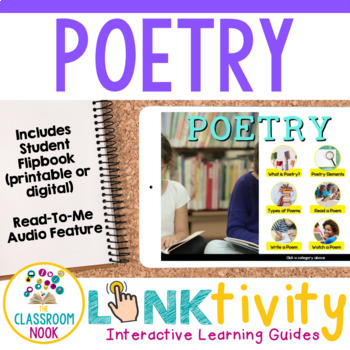Poetry LINKtivity® (Poetry Elements, Types of Poetry, Reading & Writing Poetry)
- PDF
- Google Apps™

What educators are saying
Description
Make poetry come alive and give your students a unique interactive, multimedia experience for learning about poetry elements, types of poetry, and more. The simple teacher prep and the easy-to-navigate digital LINKtivity learning guide are perfect for any upper elementary classroom (even great for substitute days)!
Your students will love this self-paced, student-controlled digital activity that allows them to discover poetry elements, different types of poetry, and much more! But - instead of it being presented in a bland way, students will enjoy video, audio, fun graphics, and more to capture (and keep!) their attention! A complete multimedia EDU-venture!
The digital LINKtivity® is designed with diverse learners in mind and uses simple, user-friendly navigation features and even provides audio support that reads text to the students -- perfect for struggling readers or English language learners!
STUDENTS WILL LEARN:
- Learn the Parts of a Poem - including title, verse, stanza, space between stanzas)
- Explore Types of Poetry types of poems include: ballad, limerick, haiku, cinquain, shape, acrostic, bio, diamante, couplet, free verse - students will learn a definition and read an example of each kind of poem
- Explore Poetry Elements - elements include: simile, metaphor, personification, onomatopoeia, hyperbole, alliteration, tone, symbolism, imagery, rhyme - students will learn a definition and read several examples of each poetry element
- Read Several Kid-Friendly Poems - students will be prompted to use different voices to convey the poem's meaning and tone, as well as be prompted to think critically about each poem
- Write Their Own Poetry - modeling after what they learn in the digital learning guide, students will be prompted to write their own poetry
- Explore Several Poetry Books - using books that you have in your classroom, school, or local libraries students will complete a "search and find" scavenger hunt where they look for poetry elements in the poems that they read.
- Animated Poetry - the LINKtivity also has several poems animated as a video for students to enjoy.
While using the digital learning guide students will complete a flipbook (printable or digital) to highlight the information that they learned in the guide.
To view the LINKtivity®, you will only need access to the internet (no fancy software or programs needed!)
The LINKtivity can be used as a whole class by projecting the digital guide on a SMARTBoard or white board, in small groups gathered around a single device or even as individuals by using personal tablets, iPads, chrome books...etc.
HERE'S WHAT IS INCLUDED:
- A user-friendly teacher guide with all links and downloads accessible directly from the guide.
- An easy-to-use LINKtivity® Interactive Learning Guide (accessible in any internet browser)
- A student flipbook (printable & digital versions available!) to authentically showcase learning
- An answer key
- A kid-friendly rubric for student guidance and easy assessment
WHAT OTHER TEACHERS ARE SAYING:
LINKtivities are a unique 21st century learning tool that will engage your learners and leave them wanting more!
Melanie says...
⭐⭐⭐⭐⭐ These were an absolute life saver last school year while teaching in person and online simultaneously. They are great activities and I will be using them as centers activities now that I know we will be fully in person. Thank you for creating such great resources!
Karen S. says...
⭐⭐⭐⭐⭐ My students love all of the Linktivity resources! I have used them for independent learning, in partners, and for distance learning. I love them!
Shauna W. says...
⭐⭐⭐⭐⭐ This activity is WONDERFUL. Such a perfect independent study for students to complete and they loved engaging in it.
YOU MAY ALSO LIKE:
Poetry Resources - The Perfect Poetry Unit Companion! (Use with ANY POEM)
----------------------------------------------------------
New to LINKtivities? >>LEARN MORE HERE</a> <<
Already LOVE LINKtivities?
Join the LINKtivity® Learning Membership! CLICK HERE to learn more!
-----------------------------------------------------------
Copyright © The Classroom Nook.
All rights reserved by author.
Permission to copy for single classroom use only.
Not for public display.
Please purchase additional licenses if you intend to share this product.





